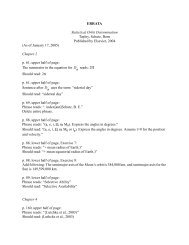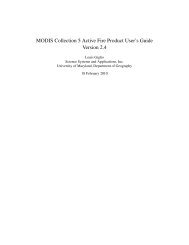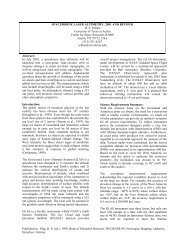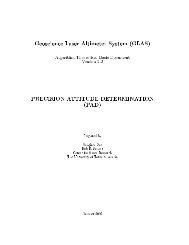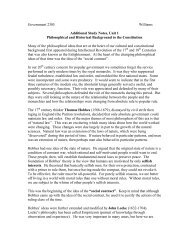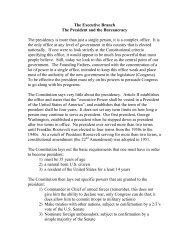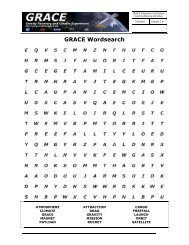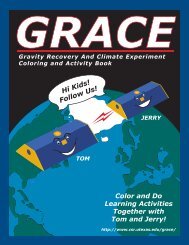Exploiting Class Hierarchies for Knowledge Transfer ... - IEEE Xplore
Exploiting Class Hierarchies for Knowledge Transfer ... - IEEE Xplore
Exploiting Class Hierarchies for Knowledge Transfer ... - IEEE Xplore
You also want an ePaper? Increase the reach of your titles
YUMPU automatically turns print PDFs into web optimized ePapers that Google loves.
RAJAN et al.: EXPLOITING CLASS HIERARCHIES FOR KNOWLEDGE TRANSFER IN HYPERSPECTRAL DATA 3413TABLE IIICLASS NAMES AND NUMBER OF DATA POINTS FORTHE MULTITEMPORAL BOTSWANA DATA SETB. Experimental MethodologyIn all the data sets, the labeled data (Area 1) were subsampled,such that 75% of the data were used <strong>for</strong> training and 25%as the test set. For both cases, a second test set was also acquiredfrom the spatially/temporally separate region (Area 2). Sincethe Area 2 test set was from a different geographic location, orwas obtained at a different time, factors such as localized geomorphology,meteorology, and atmospheric conditions as wellas changes in bidirectional reflectance and plant physiologyresulted in different hyperspectral signatures. Along with thechanges in the aprioriprobabilities of the land-cover classes,these data provide an ideal setting to test the knowledge transferframework.For our experiments, we used a BHC based on the Fisher-mfeature extractor, and the posterior probabilities were obtainedby soft combining. Adjacent hyperspectral bands that werehighly correlated were merged using the best bases featureextractiontechnique [25] prior to applying the Fisher featureextractor. Merging was per<strong>for</strong>med until the ratio of the trainingsamples to the number of dimensions was at least five at eachnode of the classifier tree [35]. For both the unsupervised andthe semisupervised cases, the classification accuracies were obtainedby averaging over five different samplings of the trainingdata (from Area 1) or the labeled Area 2 data, respectively.The ensemble of the BHC trees was generated by switchingrandomly chosen sibling classes of the original BHC tree. Thefeature extractors and the classifiers of the corresponding nodeand that of its children were then updated to reflect the perturbation.One hundred different randomized BHC trees weregenerated. The κ-diversity measure was then used to prunethe ensemble, such that the final ensemble contained the tenclassifiers with the lowest average pairwise κ measure. Earlierexperiments with a larger pool of randomized trees, from whichthe ten most diverse classifiers were chosen, yielded similarresults [28]. Note that there are no well-defined methods <strong>for</strong>determining the number of classifiers to be used in an ensemble.For our purposes, we found that generating 100 randomizedtrees <strong>for</strong>med an adequate initial pool of classifiers, from which,we selected ten.For the semisupervised scenario, using very small amounts oflabeled data to estimate the class covariance matrices resulted inill-conditioned matrices. In the knowledge transfer framework,the class covariance matrices were initially stabilized by poolingthe corresponding training data from Area 1, and the labeleddata from Area 2 to estimate the covariance matrices. Similarly,while building a new BHC using the available Area 2 data,the estimates of the ill-conditioned class covariance matricesat a particular node were stabilized by using the data pointsassociated with the corresponding parent node.Both the ML-EM classifiers were modeled using a multivariateGaussian <strong>for</strong> each class. As in the case of the BHCbasedknowledge transfer, the best bases feature extractor andthe Fisher discriminant were used to reduce the dimensionalityof the input data. The number of best bases was determinedby using a validation set from the Area 1 training data. Forthe unsupervised case, the best bases feature extractor wastransferred from Area 1 to Area 2. Area 2 data were treatedas the unlabeled data, and EM iterations were per<strong>for</strong>med asdetailed in Section III-A. For the semisupervised scenario,the constrained EM was used to update the parameters of theGaussians as well as the Fisher discriminant.For the ECOC-SVM systems, the guidelines provided in [6]were used to generate the appropriate code matrices. In ourpaper, we used the following:1) dense random code method of [36] <strong>for</strong> the KSC and themultitemporal data sets;2) BCH code matrix from [37] <strong>for</strong> the spatially separateBotswana data set.SVMs with Gaussian kernels were trained <strong>for</strong> each binaryproblem induced by the code matrix [6]. The SVM classifierswere implemented in MATLAB using the package provided in[38]. Prior to SVM classification, each feature in the trainingdata was normalized to have a zero mean and unit variance.The features of the corresponding test set were also scaledwith the means and variances computed from the training data.The parameters (Gaussian kernel width and the upper boundon the coefficients of the support vectors, “C”) of each SVMwere identified by threefold cross validation, using 40% of theavailable training data as the validation set. Different values <strong>for</strong>the Gaussian kernel widths were evaluated empirically, and theparameter, which had the least classification error over the threevalidation sets, was finally used. Having fixed the kernel width,a similar process was used to tune the “C” parameter.C. Results and DiscussionUnsupervised case: First, the BHC, the ECOC-SVM, andthe BHC ensemble built on the training data from Area 1 wereused without any modification to classify the data from Area 2.Tables IV and V contain the overall classification accuracies,along with the standard deviations of the overall accuracies,which are obtained by the baseline and the knowledge transferapproaches on the Area 2 data.As a frame of reference, <strong>for</strong> the spatially separate data, theclassification accuracies on the Area 1 test set <strong>for</strong> the BHC,ECOC-SVM, and ML + EM are 93.05%(±1.17), 93%(±1.03),and 89.15%(±1.28) <strong>for</strong> the KSC data set. For the Botswanadata set, the corresponding classification accuracies are94.52%(±0.79), 95.63%(±0.95), and 93.57%(±1.63), respectively.The substantial reduction in overall classification accuracieswhen the original classifiers were applied to spatiallyseparate test cases shows that there is a significant differencebetween Area 1 and Area 2. Because of greater homogeneitywithin the scene, the Botswana data set benefits much morefrom the in<strong>for</strong>mation in Area 1 than the KSC (Table IV).The greater disparity in the spectral signatures of the classes



